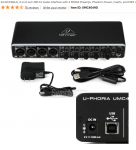We are new and have a Scarlett 2i2 interface. We purchased it because people said it was good and people used in in Youtube videos etc.
Today I was just looking at other stuff and saw that some people were using interface's that cost over £800 for single microphone vocal work
Is there really that much difference between these little boxes of tricks? Even the really expensive ones still used usb2 connections which I found strange. I thought usb 2 had been superseded long ago.
Today I was just looking at other stuff and saw that some people were using interface's that cost over £800 for single microphone vocal work

Is there really that much difference between these little boxes of tricks? Even the really expensive ones still used usb2 connections which I found strange. I thought usb 2 had been superseded long ago.

 . I just know the interface isn't going to make a difference in my recordings...
. I just know the interface isn't going to make a difference in my recordings...